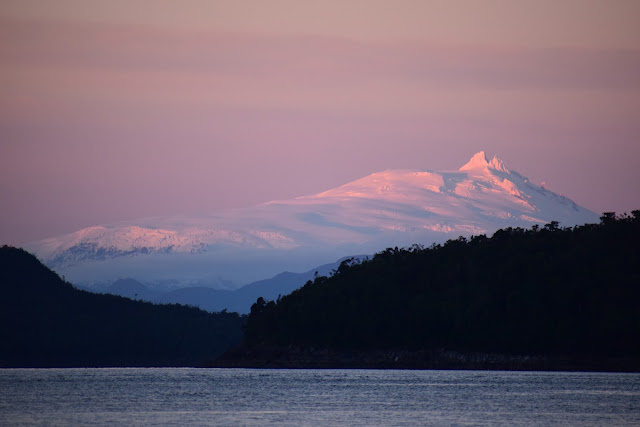Patagonia. Again.
The two lines we set up yesterday to hold Otra Vida close to shore, protecting us from the forecast northerlies, are now worse than useless – they are holding the boat sideways on to the wind and waves, increasing tension on the anchor. The forecast tells of stronger winds in the coming hours. This is not going to be pleasant.
Estero Arboles Espectrales is a deep inlet that lies WNW-ESE. Somehow the northerly wind in the main channel turns and blows straight up the estero as ESE/SE rachas. Rachas - the Spanish word for gust that in Patagonia means something more: very strong gusts. It makes no sense that the wind should behave this way, but the mystery is less important than the reality.
In the first light of day I look outside and assess our situation. Not good. We´re 20m from the shore, the lines that last night were straight behind us are now at a 45 degree angle, and the GPS tells me we have moved 30m due to the immense strain on the anchor. I let go the shorelines and we swing free. I check the depth. Otra Vida is floating in just 2.5m of water, and it´s high tide. Staying in this position won´t work.
So, we raise the anchor.
At the same time the wind increases, as forecast, and I can see rachas
coming down the estero like white brushstrokes on a dark canvas, ripping water
from the surface – meaning these gusts are at least 50kts. Otra Vida´s engine pushes us into the wind and
we anchor again, letting out all our chain, testing the anchor, and waiting.
A procession of rachas hit us one after another. Otra Vida swings at anchor, tracing a banana
shaped arc on the GPS. Good. The anchor is holding. This is not comfortable, but it is safe.
The wind increases still further. A particularly strong racha hits us,
registering 55kts at the masthead, certainly more at deck level. We start to drag. Damn.
Not a surprise, but I was hopeful.
After over a year down here I should know better than to be
hopeful. Hopeful isn´t a good strategy
in Patagonia. So, on with the engine. Lison
and Jérémie work on the foredeck in stinging spray and howling wind bringing up
the anchor, a process made more challenging by Otra Vida´s gyrations as one racha
after another pummels us. Powering as
best we can against the rachas we inch our way out to the main channel, where
the wind is indeed coming from the north as expected. There are a few possible anchorages nearby,
but they are all unknown to me and in areas without detail on our Chilean charts, so we decide to
be cautious and head 15nm south to a well charted anchorage that will be
easy to enter in these conditions and is certain to be secure. The winds in the channel are now approaching 50kts
from the north, we have a tiny amount of foresail out, and we are making
7-8kts. It´s noisy from the wind,
the rain is relentless, the waves are jostling us, but it´s not dangerous
anymore. We head south. Fast forward a couple of hours and we´re
safely anchored in Caleta Canal, sheltered from the worst of the wind by a
friendly forest.
I realise that I´ve let my guard down a little since arriving
north of Golfo de Penas. In southern
Patagonia I had learned to be diligent about considering all weather
possibilities, however unlikely they seemed, a diligence – almost a paranoia –
born of hard won experience. North of
Penas the weather is better. That´s true. But this was a reminder that Otra Vida is
still in Patagonia, even if it´s northern Patagonia.
 |
| Caleta Valverde |
Almost everyone you meet here has similar stories. It´s a counterpoint to the stories of heart-stoppingly
beautiful mountain vistas, untouched wilderness, and abundant sea life. We share our stories and try and learn from
each other. People who sail here for
years become ever more conservative in their navigation and anchoring practices,
and I more and more understand why. I
remember Larry and Mary Anne saying that they sleep comfortably in
Patagonia only when their boat is secured with at least four shorelines from four
different directions. This from a couple
who have sailed Antarctica, the Arctic, and the Northwest Passage, and who
cross oceans like others cross a street...
A few days later. The
wind is less than 7kts and is on the beam.
The sun is shining. We are making
2 knots with full sail, pretty islands to each side, a glacier capped volcano
on the horizon. Jérémie and Lison are
peeling chestnuts, ingredients for a French regional dish they are
cooking. Patty is reading, happy,
smiling. Emma Goldman, our new canine
crew member, stands guard on the bow and enjoys the light breeze in her
nostrils.
Lunch is ready. We
drift along, calmness and beauty providing a sunny backdrop, cuisine grand-mere
and good conversation filling the cockpit.
Our French crewmates´ food is sublime. Time stops ...
 |
| Moonrise over Caleta Valverde |
We pull into Caleta Valverde and drop the anchor. Patty and I swim briefly in the chilly Patagonia water while Jérémie and
Lison explore ashore. They collect a
pile of driftwood and after dark we sit around a fire on shore, Emma running back and
forth along the beach, happy as only a city dog in the wilderness for the first time can be. We pop our last bottle of Chilean champagne
under the full moon and toast life.
Patagonia. Again.



1 comment:
Truly epic, a toast to life.
Post a Comment